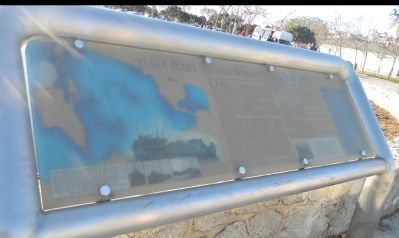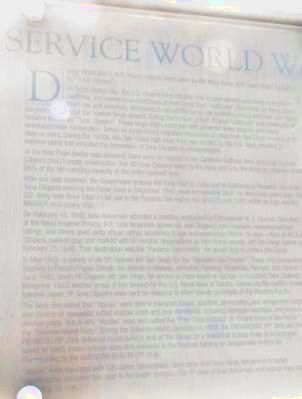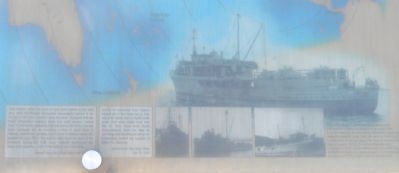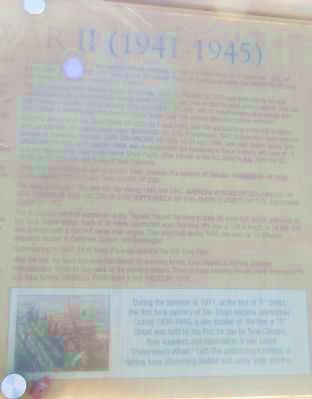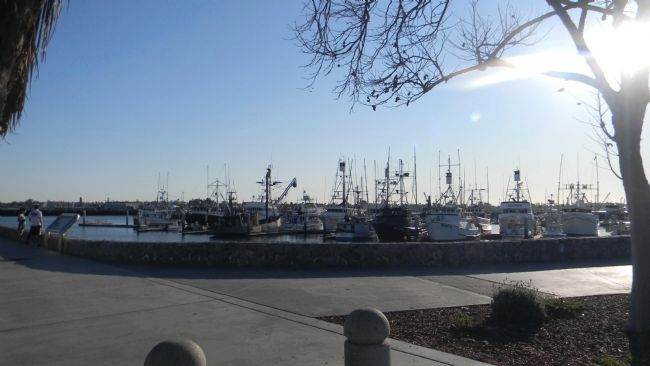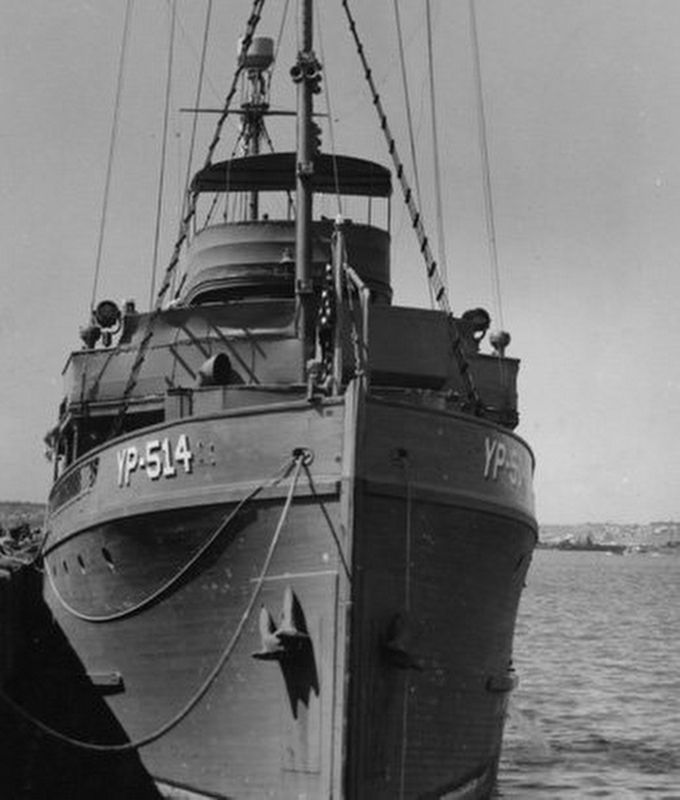San Diego in San Diego County, California — The American West (Pacific Coastal)
Tuna Fleet Service, World War II (1941-1945)
— Tuna Harbor, San Diego —
Inscription.
During World War II, 600 fishing vessels were taken by the Navy, Army, and Coast Guard, including 52 “Tuna Clippers”.
On Pearl Harbor Day, the U.S. canned tuna industry was located almost exclusively in Southern California, and canners received most of their tuna from “baitboats”. Fishermen on these boats chum live bait (sardines, anchovies) to attract the tunas into a feeding frenzy and then rigid bamboo poles to pull the hooked tunas aboard. Dating from 1924, a fleet of large “baitboats” was developed and became known as “Tuna Clippers”. These large ships, equipped with powerful diesel engines and newly developed brine refrigeration, fished for tunas found migrating thousands of miles from San Diego on trips of 90 days or more. During the 1930s, this San Diego high seas fleet was studied by the U.S. Navy, resulting in wartime plans that included the conversion of Tuna Clippers to minesweepers.
At the time Pearl Harbor was attacked, there were 90 vessels in the California baitboat fleet, including 76 Tuna Clippers plus 3 under construction. The 49 Tuna Clippers taken by the Navy and 3 by the Army represented about 55% of the fish carrying capacity of the entire baitboat fleet.
After war was declared, the Government ordered the Tuna Fleet to make port in California or Panama. Ten of the Tuna Clippers entering the Canal Zone in December 1941, were immediately taken for temporary patrol duty. The U.S. Army took three Clippers for use in the Panama Sea region, the Shasta and Cape as tugs and the Invader as a supply ship.
On February 16, 1942, tuna fishermen attended a meeting conducted by Commander W. J. Morcott, USN (Ret.) at the Naval Reserve Armory. 600 tuna fishermen signed up, with Skippers and Engineers receiving warrant ratings, and others given petty officer ratings according to age and experience. Within 10 days, a fleet of 16 Tuna Clippers, painted gray and marked with YP number designations as Yard Patrol vessels, left San Diego harbor on February 25, 1942. Their destination was the “Panama Sea Frontier” for picket duty to protect the Canal.
In May 1942, a convoy of six YP Clippers left San Diego for the “Hawaiian Sea Frontier”. These YPs transported supplies to French Frigate Shoals, the islands of Midway, Johnston, Fanning, Christmas, Palmyra, and Canton. In June 1942, seven YP Clippers left San Diego, for service at Efate Island or Samoa, or Auckland, New Zealand. In November 1942, another group of five headed for the U.S. Naval base at Tutuilla, Samoa. As the conflict moved towards Japan, YP Tuna Clippers were sent on missions to other Islands and Atolls
of the Western Pacific.
The Navy discovered that “Yippies” were also called the “Pork Chop Express” or “Errand Boys of the Pacific” or the “Solomon Island Ferry”. During the Solomon Island Campaign in 1942, the Paramount (YP 289) and the Picoroto (YP 290) delivered frozen turkeys and all the fixings for a traditional holiday feast at Guadalcanal Island. In 1943, frozen turkeys were also delivered to the Marines fighting on Bougainville in time for Thanksgiving by the American Beauty (YP-514).
“Yippies” were equipped with CW radios, fathometers, Navy radar and Navy sonar. Armament included machineguns, and other gun gear to fire Depth charges. The YP crew of tuna fishermen and regular Navy ran from 4 to 20 men.
Two YPs were sunk in the Solomon Islands campaign by enemy surface ships. On 9 September 1942, off Tulagi Island, the Prospect (YP-346) and on 25 October 1942 off Guadalcanal Island, the Endeavor (YP-284). The number of casualties sustained is unknown.
Two YPs were lost in the Midway region. On 23 May 1942, the Triunfo (YP 277) was destroyed by fire and explosions en route to French Frigate Shoals (North of Hawaii), and then scuttled to avoid enemy capture. Only two crewmembers survived. During October 1942, the Yankee (YP-345),
with 17 crewmembers, on a voyage from Pearl Harbor to Midway Island via French Frigate Shoals was “lost without trace from causes unknown”.
Four YPs were lost sea: California (YP-235) on 1 April 1943, after fire and beaching in the Gulf of Mexico from an explosion of undetermined origin; Navigator (YP-279), 5 September 1943, foundered in heavy weather en route to Townsville, Australia; Cape San Vincent (YP-280), on 24 April 1946, sank near Saipan Island; San Salvador (YP-281) on 9 January 1944, was destroyed after the foundering in Force 9 storm, with crew of 19 and one dog rescued, near Wallis Island, South Pacific. After transfer to the U.S. Army in July, 1943 the Sea Tern (ex-YP-269) was lost at sea off Baja California.
Three YPs were destroyed during October 1945 because of a typhoon off Okinawa: Paramount (YF-289); Counte Grande (YP-520) and Challenger (YP-239). The Navy destroyed 7 YPs after the War during 1946 and 1947: American VoyagerCipango (YP-504), Europa (YP-236), Falcon (YP-515), Queen Anelia (YP-516), Queen Elizabeth (YP-519), and Yvonne Louise (YP-282).
The successful wartime experience of the “Yippies”, caused the Navy to build 30 wood-hull vessels patterned on the Tuna Clipper design. Each of
30 newly constructed Navy YPs was of 128 128 in length, of 14 feet draft, and powered with a 500 H.P. diesel main engine. They were built during 1945, two each by 15 different shipyards located in California, Oregon, and Washington. Commencing in 1947, 24 of these YPs were added to the U.S. Tuna Fleet.
After the war, the Navy and Army transferred 33 surviving former Tuna Clippers to the War Shipping Administration (WSA) for buy-back by the previous owners. Three of these surviving vessels never returned to the U.S. tuna fishery: Cabrillo, Fisherman II, and Theodore Foss.
Photo captions, lower left:
Tuna clippers joined the navy too and were painted a dull slate grey, while the stalwart Portuguese descendants learned to fire the guns that were mounted upon the deck. Equipped with the fines refrigeration systems, these trim craft became “errand boys” of the Pacific; delivering food and fuel to the fronts. One day these tunaboats will be convoying a fleet of small ships to Panama. Next month, perhaps, they’ll be off to Midway Island with gasoline for navy PBYs. Two months later, they’ll be down in the Solomons running the “milk route” between Guadalcanal and Tulagi with supplies – part of the saga of men and boats.
excerpt from: San Diego Union, July 23, 1943.
Photo
captions, lower middle :
During the summer of 1911, at the foot of “F” Street, the first tuna cannery of San Diego became operational. During 1930-1949, a pier located at the foot of “G” Street was built by the Port for use by Tuna Clippers, their suppliers and Association; it was called “Fishermen’s Wharf.” Left: The predominant method of fishing tuna: chumming livebait and using “pole and line.”
Scores of converted tuna clippers slipped out of San Diego Bay on their way to do valiant work in Pacific battle areas. First boats sailed from here Feb. 25, 1942. These small, sturdy, diesel-powered boats are ideal for conveying and patrolling as well as for transporting needed war supplies to defeat the Japanese.
excerpt from: San Diego Union, July 23, 1943.
"California Tuna Clippers: Military Service WWII" [summations of service histories for individual vessels]
Erected 2008 by San Diego Port Commission.
Topics and series. This historical marker is listed in these topic lists: Industry & Commerce • Notable Events • War, World II • Waterways & Vessels. In addition, it is included in the Lost at Sea series list. A significant historical date for this entry is January 9, 1944.
Location. 32° 42.735′ N, 117° 10.397′ W. Marker is in San Diego, California, in San Diego County. Marker is at the intersection of the San Diego Embarcadero and W. G Street on the San Diego Embarcadero. Marker is one block west of N. Harbor Drive, opposite the USS San Diego (CL-53) Memorial. Touch for map. Marker is in this post office area: San Diego CA 92101, United States of America. Touch for directions.
Other nearby markers. At least 8 other markers are within walking distance of this marker. USS San Diego Memorial (a few steps from this marker); Clifton A. F. Sprague, Vice Admiral, USN (about 300 feet away, measured in a direct line); United States Aircraft Carrier Memorial (about 500 feet away); La Punta de los Muertos (approx. 0.2 miles away); San Diego Barracks (approx. 0.2 miles away); Bridle-Arrest "Horns" (approx. 0.2 miles away); Charles I.D. Looff (approx. ¼ mile away); San Diego: Birthplace of Naval Aviation (approx. ¼ mile away). Touch for a list and map of all markers in San Diego.
Related marker. Click here for another marker that is related to this marker. To better understand the relationship, study each marker in the order shown.
Also see . . .
1. "Former Tuna Fishermen sail "Yippee" Boats Against The Japs". Prescott Evening Courier - Sep 7, 1943 (Submitted on September 28, 2020, by Larry Gertner of New York, New York.)
2. Yard patrol boat. Wikipedia entry. (Submitted on September 28, 2020, by Larry Gertner of New York, New York.)
3. History of Tuna Harbor . Port of San Diego website. (Submitted on September 28, 2020, by Larry Gertner of New York, New York.)
4. NavSource Photo Archives: District Patrol Vessel / Craft (YP) Index. Listing of all vessels with a YP designation, with photo/service history where available. (Submitted on September 28, 2020, by Larry Gertner of New York, New York.)
Credits. This page was last revised on September 28, 2020. It was originally submitted on February 7, 2012, by Richard E. Miller of Oxon Hill, Maryland. This page has been viewed 3,336 times since then and 156 times this year. Photos: 1, 2, 3, 4, 5. submitted on February 7, 2012, by Richard E. Miller of Oxon Hill, Maryland. 6. submitted on September 28, 2020, by Larry Gertner of New York, New York. • Syd Whittle was the editor who published this page.
